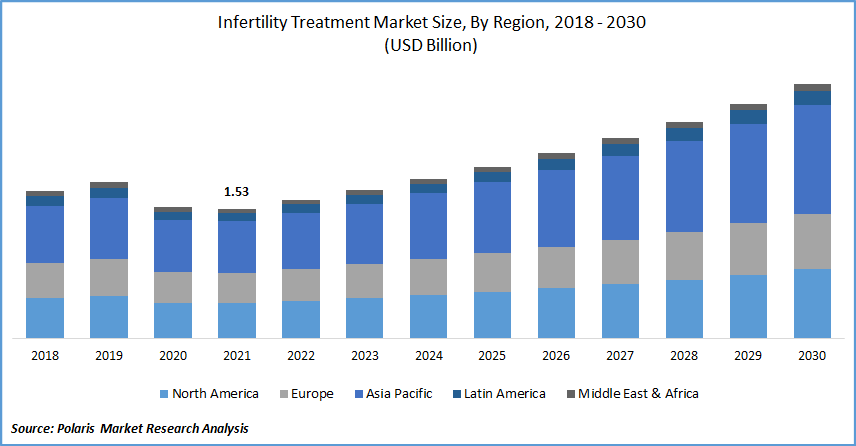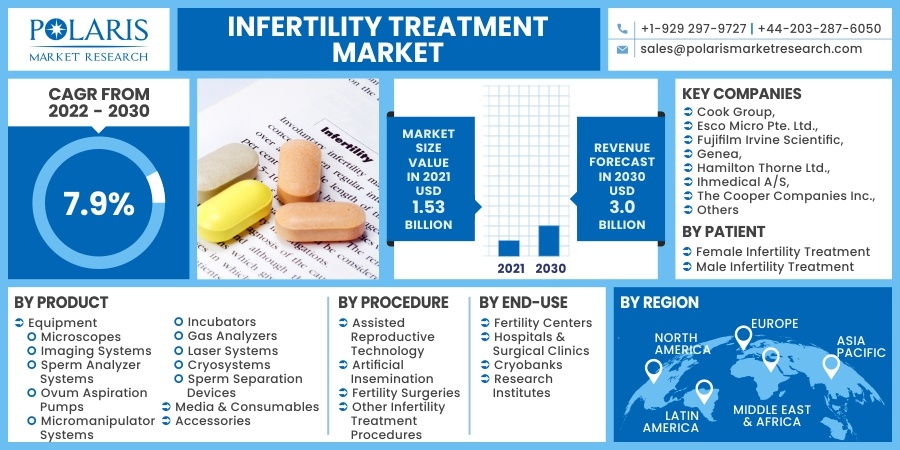
Infertility Treatment Market Share, Size, Trends, Industry Analysis Report
By End-Use (Fertility Centers, Hospitals & Surgical Clinics, Cryobanks, Research Institutes); By Product; By Procedure; By Patient; By Region; Segment Forecast, 2022 - 2030
- Published Date:Jan-2022
- Pages: 115
- Format: PDF
- Report ID: PM2169
- Base Year: 2021
- Historical Data: 2018 - 2020
Report Outlook
The global infertility treatment market was valued at USD 1.53 billion in 2021 and is expected to grow at a CAGR of 7.9% during the forecast period. Infertility is the inability of an individual to reproduce by natural means. It can be caused by various conditions, including genetics, STI (Sexually transmitted Infections), immune infertility, uterine fibroids, tubal blockage, and others.
 Know more about this report: request for sample pages
Know more about this report: request for sample pages
According to CDS, every 1 in 8 couples face complications in the US, i.e., over 12% of married women face complications in attaining pregnancy. The increasing number of infertility cases globally is anticipated to drive the growth of the industry. The industry growth's primary factors include the declining fertility rate, an increasing number of fertility clinics, and growing technological advancements, among others.
The spread of the COVID-19 reflects the downfall in the industry growth on account of the significant challenges faced by patients and clinical healthcare providers globally. A few of the major challenges include logistical issues, prioritizing patients with comorbidities & pre-existing diseases, managing patients with the disease, and protecting hospital and public frontline workers from exposure to the COVID-19 virus. The treatments such as IUI (Intrauterine insemination) and IVF (In Vito Fertilization), require in-person appointments.
The cancellation of all such treatments on account of the pandemic is anticipated to hinder the growth of the industry. For instance, during the pandemic, a drop of over 90%was noticed in the number of people going through such treatments. Further, lockdown measures and limited consumer spending are anticipated to hamper the development. However, the need for the industry is projected to bounce back as governments across nations are lifting lockdown restrictions.

Know more about this report: request for sample pages
Industry Dynamics
Growth Drivers
The primary factor driving the growth of the global industry is the declining fertility rate. The decline in infertility can be attributed to the rising trend of late marriages, increasing age-related infertility, growing obesity, and other diseases such as diabetes and others. For instance, according to the UN (United Nations), the fertility rate across the globe is anticipated to decrease to around 2.4 children/woman, by 2030 and 2.2 children/woman, by 2050. This decline in the global fertility rate is anticipated to increase the demand for such treatments and products.
Further, the emerging markets in the Asia Pacific, Brazil, and Mexico are estimated to offer lucrative growth opportunities. The industry in these regions is characterized by the improving healthcare infrastructure and rising medical tourism on account of affordable medical treatments when compared to developed nations.
Moreover, the rising awareness regarding the treatments pertaining to infertility, such as IVF and IUI, among others, is expected to boost the demand for the infertility treatment market globally. The new product launches by industry players are anticipated to present growth opportunities. For instance, in March 2019, Vitrolife, one of the leading time-lapse system providers that are used in assisted reproduction, launched EmbroyoScope+.
Report Segmentation
The market is primarily segmented on the basis of product, procedure, patient, end-use, and region.
|
By Product |
By Procedure |
By Patient |
By End-Use |
By Region |
|
|
|
|
|
Know more about this report: request for sample pages
Insight by Product
The equipment segment is recorded to hold the larger shares in 2021 and is expected to lead the industry in the forecasting years. This huge share of the segment can be attributed to the field's technological advancements and the presence of industry players with a wide product portfolio. The growing focus of the industry players towards expansion through the adoption of various strategies such as new product launches and collaboration for sale partners, among others, is estimated to boost the growth of the segment. For instance, in April 2018, Baker Ruskinn partnered with I&L Biosystems as its UK sales partner, aiming to expand its distribution in the UK industry.
The sperm separation segment is projected to show the fastest growth rate in the forecasting years. The sperm separation devices are utilized in most of the ARTs (Assisted Reproductive Technology), such as artificial insemination and IVF. Sperm separation devices are crucial for ARTs to get purified samples for further procedures. The growing demand for the infertility treatment market globally is anticipated to drive the growth of the segment.
Geographic Overview
Geographically, Asia Pacific is accounted with the highest share in the global market in 2021 and is estimated to lead the industry during the forecasting years. This huge share can be attributed to the significant rise in medical tourism coupled with the rising awareness regarding the availability of such treatment procedures. Moreover, the rising number of fertility clinics and the increasing rate of infertility in the region is anticipated to offer huge market growth opportunities in the region.
Further, the growth of the market is fueled by rapid urbanization, improving living standards, and rising disposable income along with the rise in healthcare expenditure of the population in the emerging nation. The emerging nations such as South Korea, India, Japan, and China are primarily attributing towards the market growth.
The growing initiatives by the government in order to increase the accessibility of infertility treatment are further estimated to boost the growth of the market in the region. Additionally, the reduction in infertility treatment costs and the improvement of healthcare infrastructure in emerging nations is projected to drive market growth.
Moreover, the North American infertility treatment market is anticipated to exhibit a progressive CAGR over the forecasting years. The fast growth of the market in the region can be attributed to the various reimbursement schemes coupled with the rising infertility rate. The advent of advanced technologies offering huge growth for fertility clinics, device manufacturers, and hospitals is anticipated to drive the growth of the market in the region. Further, the increasing investments in research & development, favorable regulations, and high patient awareness in North America are expected to boost the demand for the infertility treatment market.
Competitive Insight
Some of the major players operating in the global market include Cook Group, Esco Micro Pte. Ltd., Fujifilm Irvine Scientific, Genea, Hamilton Thorne Ltd., Ihmedical A/S, Ivftech, Kitazato Corporation, Rocket Medical Plc, The Baker Company, Inc., The Cooper Companies Inc., Thermo Fisher Scientific, Vitrolife, and Zeiss Group.
Infertility Treatment Market Report Scope
|
Report Attributes |
Details |
|
Market size value in 2021 |
USD 1.53 billion |
|
Revenue forecast in 2030 |
USD 3.0 billion |
|
CAGR |
7.9% from 2022 - 2030 |
|
Base year |
2021 |
|
Historical data |
2018 - 2020 |
|
Forecast period |
2022 - 2030 |
|
Quantitative units |
Revenue in USD billion and CAGR from 2022 to 2030 |
|
Segments covered |
By Product, By Procedure, By Patient, By End-Use, By Region |
|
Regional scope |
North America, Europe, Asia Pacific, Latin America, Middle East & Africa |
|
Key companies |
Cook Group, Esco Micro Pte. Ltd., Fujifilm Irvine Scientific, Genea, Hamilton Thorne Ltd., Ihmedical A/S, Ivftech, Kitazato Corporation, Rocket Medical Plc, The Baker Company, Inc., The Cooper Companies Inc., Thermo Fisher Scientific, Vitrolife, and Zeiss Group. |
